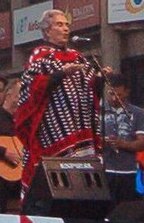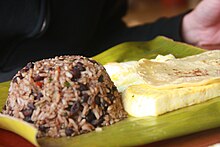Culture of Costa Rica
Costa Rican culturehas been heavily influenced bySpanish cultureever since theSpanish colonization of the Americasincluding the territory which today formsCosta Rica.Parts of the country have other strong cultural influences, including theCaribbeanprovince ofLimónand theCordillera de Talamancawhich are influenced by Jamaican immigrants and indigenous native people, respectively.[citation needed]
Ethnic groups
[edit]





As of 2012[update]most Costa Ricans are of primarily Spanish or Spanish/Mixed ancestry with minorities of German, Italian, French, Dutch, British, Swedish and Greek ancestry. Whites,CastizoandMestizotogether comprise 83% of the population.[1]
European migrants in Costa Rica to get across the isthmus of Central America as well to reach the USA West Coast (California) in the late 19th century and until the 1910s (before thePanama Canalopened). Other European ethnic groups known to live in Costa Rica include Russians, Danes, Belgians, Portuguese, Croats, Poles, Turks, Armenians and Georgians.
Many of the first Spanish colonists in Costa Rica may have been Jewish converts to Christianity who were expelled from Spain in 1492 and fled to colonial backwaters to avoid the Inquisition.[2]The first sizable group of self-identified Jews immigrated from Poland, beginning in 1929. From the 1930s to the early 1950s, journalistic and official anti-Semitic campaigns fueled harassment of Jews; however, by the 1950s and 1960s, the immigrants won greater acceptance. Most of the 3,500 Costa Rican Jews today are not highly observant, but they remain largely endogamous.[3]
Costa Rica has four small minority groups:Mulatto,Black,AmerindianandAsianpeople. About 8% of the population is of African descent or Mulatto (mix of European and black) who are calledAfro-Costa Ricans,descendants of Sub-Saharan Africans enslaved by the Spanish, and descendants of 19th century English-speakingJamaicanimmigrant workers.[4]
In 1873, the Atlantic Railroad imported 653 Chinese indentured laborers, hoping to duplicate the success of rail projects that used Chinese labor in Peru, Cuba, and the United States. Asians represent less than 0.5% of the Costa Rican population, mostly from China, Taiwan and Japan.
There are also over 104,000Native Americanor indigenous inhabitants, representing 2.4% of the population. Most of them live in secluded reservations, distributed among eight ethnic groups:Quitirrisí(in the Central Valley),MatambúorChorotega(Guanacaste),Maleku(northern Alajuela),Bribri(southern Atlantic),Cabécar(Cordillera de Talamanca),Guaymí(southern Costa Rica, along the Panamá border),Boruca(southern Costarable portion of the Costa Rican population is made up ofNicaraguans.[5]There is also a number ofColombianrefugees. Moreover, Costa Rica accepted many refugees from various other Latin American countries fleeing civil wars and dictatorships during the 1970s and 1980s – notably fromEl Salvador,Chile,Argentina,Cubaand recently fromVenezuela.
Currently immigrants represent 9% of the Costa Rican population, the largest in Central America and the Caribbean. By 2014 the three largest Immigrant Diasporas inCosta Ricaare people from:Nicaragua,ColombiaandUnited States.
Language
[edit]The official language ofCosta RicaisSpanish.[6]However, there are also many local indigenouslanguages in Costa Rica,such asBribrí.[7][8]English is the first foreign language and the second most taught language inCosta Rica,followed by French, German, Italian and Chinese.[9]A creole language calledMekatelyuis also spoken in Limón.[10]
Pura vida
[edit]Pura vida,a characteristic Costa Rican phrase, literally meanspure life,withconnotationsthat suggest translations such as "full of life", "this is living!", "going great", or "real living".[11][12][13]The phrase can be used both as a greeting or a farewell, as an answer expressing that things are going well, as a way of giving thanks, or showing appreciation.[14]In modern-day usage, the saying goes beyond its simple translation: it's a way of life. It is a perspective on life that evokes a spirit that is carefree, laid back and optimistic.
According to Víctor Manuel Sánchez Corrales of theUniversity of Costa Rica,the origin of the phrase isMexican.It is thought to have come from a Mexican film called¡Pura vida!(1956). The protagonist, played byAntonio Espino,used the expression "pura vida" extensively in situations where it would not normally be used. Costa Ricans adopted the phrase, using it in a similar way. It was formally recognized and incorporated into dictionaries in the mid-1990s[15]and has since become Costa Rica's unofficial but ubiquitous motto.[16]
Religion
[edit]A 2007 survey conducted by theUniversity of Costa Rica,found that 70.5% of the population identify themselves asRoman Catholics(with 44.9% practicing, 25.6 percent nonpracticing), 13.8% areEvangelicalProtestants, 11.3% report that theydo not have a religion,and 4.3% declare that they belong to another religion.[17]
There are several other religious festivals in the country; Costa Rica has various religious denominations:Buddhism,Hinduism,Judaism,Islam,Baháʼí Faith,Scientology,Rastafari,TaoismandJehovah's Witness.
Education
[edit]Education is highly cared about in Costa Rica by most of the population. About 6% of the country's domestic product is dedicated to education,[18]which has produced positive results as 96% of the population is literate. Primary (1st-6th grade) and secondary (7th-11th or 12th) are mandatory for all citizens. Public schools are free, and those who can afford it may choose to send their children to private schools.
The country has five major public universities: theUniversity of Costa Rica(UCR), theCosta Rica Institute of Technology(TEC), theUniversidad Nacional(UNA), theUniversidad Técnica Nacional,and theUniversidad Estatal Distancia(UNED).[19]
Art
[edit]
Painting and sculpture
[edit]At the beginning of the 19th century, some wealthy Costa Ricans paid visiting foreign painters, usually European, to paint their portraits.[20]It was not until some of these painters, such as Bigot, Henry Etheridge, or Santiago Paramo settled in the country that Costa Rican artists learned modern techniques for drawing, oil painting, and sculpture.[20]These teachers directly influenced Tico artists Jose Maria Figueroa, Faustino Montes de Oca, and Felipe Valentini.
Towards the end of the 19th century Costa Ricans produced artists with stronger national identities. A short list of these artists would include Ezequiel Jimenez, Wenceslao de la Guardia, and Enrique Echandi. Current renowned Costa Rican painters includeGonzalo Morales Sáurez,Rafa Fernandez,andFernando Carballo,and sculptors such asIbo Bonilla,Max Jimenez,Jorge Jimenez Deredia,Domingo Ramos, Mario Parra, Olger Villegas, Nestor Zeledon, and William Villanueva Bermudez.
Music
[edit]Most of the music and folklore comes from the north of the country, including theNicoya Peninsula(Mayan culture) and the Atlantic coast (Afro-Caribbean culture).Costa Rican musicis marked by a rhythm known astambito,as well as a distinctive musical genre known aspunto.Two examples are thepunto guanacastecofromGuanacaste Province,and thesancarleñofrom San Carlos inAlajuelaProvince.
Dance
[edit]Dance remains an important cultural tradition in Costa Rica. Most Costa Ricans learn several traditional dances from a young age. The vast majority of Costa Rican traditional dances were born in the province ofGuanacaste.National holidays are often celebrated by spirited displays of dancing in the streets.[21]
Many consider thePunto guanacastecoto be the national dance, which showcases three different stages of courtship. Occasionally, all dancers will pause mid-dance so that one person can shout out abomba.Abombais a rhymed verse which can be memorized or improvised and is usually racy or witty.[21]
Writing
[edit]Costa Rican literature has many women who have played a large role in every literary movement. Most notably,Carmen Lyrawhose overall subject matter and perspective made her a revolutionary figure.[22]Other well known authors includeJose Leon Sanchez,Aquileo J. Echeverría(Concherías),Manuel González Zeledón(La propia),Joaquin Gutierrez(Cocori, Puerto Limón, Manglar),Carlos Luis Fallas(Marcos Ramírez, Mamita Yunai),Carlos Salazar Herrera(Cuentos de angustias y paisajes),Isaac Felipe Azofeifa,Fabián Dobles,Jorge Debravo,Alberto Cañas Escalante,Andrés Meza Murillo,Yolanda OreamunoandEunice Odio.
Cuisine
[edit]
Costa Rican cuisine is a combination of Spanish, South American, Caribbean, and American influences. This style of cuisine is shared by most ofCentral America,although local variations have appeared in each of the countries.
One national dish isgallo pinto( "spotted rooster" ), although the name has no relation to the ingredients. It is a combination of black beans and white rice, spiced with cilantro, onions, garlic, salt, and a local condiment calledSalsa Lizano.It is typically eaten at breakfast with eggs, and sometimesnatilla(sour cream). Friedplantainsand either corntortillasor bread are also common.Gallo pintois a common and typical dish in both Costa Rica and Nicaragua.
Other typical dishes arearroz con pollo,olla de carne,tamales,andcasado.Arroz con pollo(rice with chicken) consists of bite size chicken chunks mixed with rice and diced vegetables that include carrots, peas, corn, andgarbanzo beans.Olla de carneis mainly prepared on weekends.[citation needed]It is a broth of corn prepared by boiling water, meat, and whole to large-sized vegetable pieces with spices. The soup is eaten in a bowl with the broth and separate plates for the vegetables and rice.
Acasadois a one-plate meal that includes black beans, rice, meat, fried plantains, and one or more side dishes. The meat can vary from chicken, beef, or fish. Some examples of side dishes are pasta salad, vegetable salad, fried eggs, potatoes, spaghetti, orbarbudos(green beans wrapped in egg batter).[citation needed]
There are some regional differences. For example, the Caribbean side of the country, because of its roots, hasgallo pintowith coconut milk, while the north-western part of the country has a strong tendency towards corn products and for large, cheese filled tortillas, corn snacks, and other dishes.
See also
[edit]- Architecture of Costa Rica
- Cultural Properties of Costa Rica
- Media of Costa Rica
- Public holidays in Costa Rica
- List of festivals in Costa Rica
- List of museums in Costa Rica
References
[edit]- ^ Costa Rica.State.gov (2012-04-09). Retrieved on 2012-05-19.
- ^"The Jewish Community in Costa Rica".jcpa.org.Retrieved4 October2017.
- ^"Culture of Costa Rica - history, people, women, beliefs, food, customs, family, social, marriage".Everyculture.Retrieved4 October2017.
- ^"Afro-Costa Ricans in Costa Rica".Minority Rights Group.Retrieved2024-04-09.
- ^state.govBackground Note: Costa Rica – People
- ^"Constitution of Costa Rica 1949 (rev. 2011)".constituteproject.org.Retrieved2015-10-08.
- ^Umaña, Adolfo Constenla; Rojas, Eugenia Ibarra (2009-03-01)."Mapa de la distribución territorial aproximada de las lenguas indígenas habladas en Costa Rica y en sectores colindantes de Nicaragua y de Pa namá en el siglo XVI".Estudios de Lingüística Chibcha(in Spanish).ISSN1409-245X.
- ^"Costa Rica".Ethnologue.Retrieved2015-10-08.
- ^"Costa Rica Culture".costaricavibes.13 September 2019.Retrieved2021-05-08.
- ^"Jamaican Creole English".Ethnologue.Retrieved2015-10-08.
- ^"What does Pura Vida mean? Costa Rican way of life".bestcostaricantours.Archived fromthe originalon 2019-12-07.Retrieved2015-10-08.
- ^Biddle, Buffie (2015-08-07).Pura Vida Mae!: An Original Story for Children.Dog Ear Publishing.ISBN9781457539770.
- ^Kaiser, James (2015-01-01).Costa Rica: The Complete Guide, Eco-Adventures in Paradise.Destination Press.ISBN9781940754017.
- ^Pura Vida!Archived2016-06-22 at theWayback Machine¡Hola Costa Rica!In Spanish: "Pura Vida también expresa el momento en que hacemos algo bien sin tratarse de un saludo y una forma de dar las gracias por algo que esté bien."
- ^La película que nos heredó el ¡pura vida!Nación,2013-01-05.
- ^"National Motto".Costa Rica.Retrieved2018-01-03.
- ^International Religious Freedom Report 2008: Costa Rica.United StatesBureau of Democracy, Human Rights and Labor(September 14, 2007).This article incorporates text from this source, which is in thepublic domain.
- ^es:Constitución Política de Costa Rica de 1949[circular reference]
- ^"Universidad Estatal a Distancia - Institución Benemérita de la Educación y la Cultura".uned.ac.cr.
- ^ab"infocostarica".Infocostarica.Archived fromthe originalon 4 October 2017.Retrieved4 October2017.
- ^abHelmuth, Chalene (2000).Culture and Customs of Costa Rica.
- ^Helmuth, Chalene (2000).Culture and customs of Costa Rica.Westport, Conn.: Greenwood Press.ISBN9780313095917.OCLC647818592.



